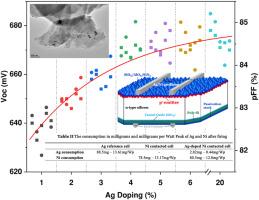用于工业 n-TOPCon 硅太阳能电池的丝网印刷掺银镍金属化技术
IF 6.3
2区 材料科学
Q2 ENERGY & FUELS
引用次数: 0
摘要
本研究为TOPCon硅太阳能电池引入了一种创新的掺银镍金属化技术,为传统的银基触点提供了一种具有成本效益的替代方案。掺银量为4%的镍浆的转换效率为23.66%,而与银接触的镍浆的转换效率为23.71%。Ag-Ni金属浆料中使用的定制工程玻璃熔块在烧制后作为孔选择层,通过改善载流子转移并将接触电阻降低到0.98 mΩ cm2,提高了太阳能电池的性能。值得注意的是,该方法将银的使用量降低到0.5 mg/Wp以下,从而大大降低了金属化成本,而传统的丝网印刷金属化通常需要13 - 20mg /Wp的银。此外,平准化电力成本(LCOE)大幅降低,证明了这种方法在大规模太阳能生产中的经济可行性。这些发现强调了ag掺杂Ni触点在解决太阳能电池制造的可扩展性和可持续性挑战方面的潜力。本文章由计算机程序翻译,如有差异,请以英文原文为准。

Screen printed Ag-doped nickel metallization for industrial n-TOPCon silicon solar cells
This study introduces an innovative Ag-doped Ni metallization technique for TOPCon silicon solar cells, offering a cost-effective alternative to traditional silver-based contacts. Employing nickel paste doped with only 4 % silver a conversion efficiency of 23.66 % was achieved compared to silver-contacted counterparts, with an efficiency of 23.71 %. The custom-engineered glass frit used in the Ag-Ni metal paste, acting as a hole-selective layer after firing, enhanced the performance of the solar cells by improving carrier transfer and reducing contact resistance to 0.98 mΩ cm2. Significantly, this method reduced silver usage to less than 0.5 mg/Wp, leading to a dramatic decrease in metallization costs in which conventional screen-printed metallization typically requires 13–20 mg/Wp of silver. Additionally, the Levelized Cost of Electricity (LCOE) was substantially lowered, demonstrating the economic viability of this approach for large-scale solar energy production. These findings underscore the potential of Ag-doped Ni contacts in addressing the scalability and sustainability challenges of solar cell manufacturing.
求助全文
通过发布文献求助,成功后即可免费获取论文全文。
去求助
来源期刊

Solar Energy Materials and Solar Cells
工程技术-材料科学:综合
CiteScore
12.60
自引率
11.60%
发文量
513
审稿时长
47 days
期刊介绍:
Solar Energy Materials & Solar Cells is intended as a vehicle for the dissemination of research results on materials science and technology related to photovoltaic, photothermal and photoelectrochemical solar energy conversion. Materials science is taken in the broadest possible sense and encompasses physics, chemistry, optics, materials fabrication and analysis for all types of materials.
 求助内容:
求助内容: 应助结果提醒方式:
应助结果提醒方式:


